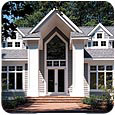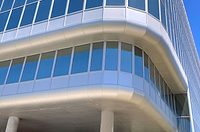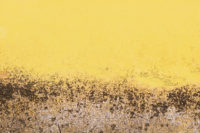High-Performance Architecture

Coil and extrusion coatings formulated using PVDF have proven to be durable and long-lasting. Photo courtesy of Arkema Inc.
UV rays. Air pollution. Acid rain. These are just some of the conditions that conspire to undermine the integrity and beauty of structures such as high-rise office buildings, corporate headquarters, apartments, condominiums and home exteriors. To ensure that metal building components can stand up to the rigors of exterior wear, manufacturers of these products need to meet stringent standards, such as the industry’s American Architecture Manufacturers Association (AAMA) 2605-05 coating specification. (See sidebar at the end of the article.) Modern coil and extrusion coatings formulated with advanced fluoropolymers are increasingly being used to protect aluminum, galvanized steel and aluminized steel and provide the metal substrate with a beautiful, long-lasting, functional finish.

Figure 1. Gloss retention in commercial coatings measured by sun exposure time in Florida. Coatings based on KYNAR 500®* PVDF exhibit superior durability and weatherability compared to other coating types. Source: Arkema Inc.
*Kynar 500 is a registered trademark of Arkema Inc.
*Kynar 500 is a registered trademark of Arkema Inc.
Coil and Extrusion Coating
Coil coated metal can be bent, crimped and twisted, allowing it to be used for unlimited design potential. Though not new, coil coating differs from other processes used to factory-apply coatings. With coil coating, paint is applied (after the metal is cleaned and pre-treated) to both sides of bare, unwound coils of metal using a reverse roll-coating finishing line. Coil coating provides a cost-effective method for applying color and protection to metal substrates using a process that is low in volatile organic compound (VOC) emissions.Aluminum extrusions are typically coated on horizontal or vertical paint lines. These conveyorized lines are used for cleaning, pre-treating and coating, with powder or liquid coatings sprayed using conventional spray equipment, bells or electrostatic discs. In both cases, the coating is then cured before the end-product is either fabricated or fully assembled.

Coil coated metal can be bent, crimped and twisted, allowing it to be used for unlimited design potential.
PVDF Advantages
Fluoropolymer-based coatings have been the coating of choice for coil and extrusion coating processes for about 40 years, and they remain popular - approximately 20% by volume of coatings sold for coil and extrusion processes are fluoropolymer-based. Other types of fluoropolymer resin are now being used in formulating these coatings, but a wide body of research conducted over the past four decades indicates that the most durable, long-lasting coil coatings are formulated using polyvinylidine difluoride (PVDF) (see Figure 1). PVDF bears a unique molecular signature that allows it to provide photochemical protection, which results in superior durability and weatherability compared to other fluoropolymers.One reason for the superior performance of PVDF is its semi-crystalline structure. The carbon-fluorine bond is the basis for the thermal, chemical and ultraviolet (UV)-resistance properties of all fluoropolymers, beginning with the atomic structure of fluorine and the number of fluorine atoms present. The high electronegativity and small atomic radius of fluorine atoms enables them to foster one of the strongest chemical bonds.
PVDF contains alternating carbon/fluorine and carbon/hydrogen bonds, so every carbon/hydrogen bond is adjacent to four carbon/fluorine bonds. The result is a state close to dynamic equilibrium - the resin is virtually inert and is therefore photochemically and electrochemically stable. It is also compatible with a variety of other polymers, and it is resistant to impact and abrasion, oxidation, fading, chalking, cracking, corrosion, dirt, acid and airborne pollutants, mildew and fungal growth, and chemical staining.

Modifiers and Pigments
Extensive testing in the harsh environment of South Florida has shown that a formulation should be c omposed of at least 70% PVDF to ensure optimum performance. Other components also contribute to the coating’s appearance and durability.For example, PVDF-based coatings typically incorporate an acrylic modifier to ensure outstanding gloss and color retention. Often the acrylic modifier used in these coatings is a thermoplastic or thermoset acrylic selected to improve pigment dispersion and coating adhesion.
Pigments added to PVDF-based coatings are selected to provide aesthetics, color stability and UV light opacity. PVDF is completely resistant to degradation by UV light, but without opaque pigments, UV light can pass through these coatings and attack underlying paint layers, such as the primer coat.
The solvents most commonly used in PVDF-based coatings are latent solvents used to produce dispersion coatings. When heat is applied during the baking cycle, the resin solubilizes in the solvent to form a uniform film as the solvent evaporates. PVDF-based coatings are typically cured at 450°F.
A Durable Finish
PVDF-based coatings have stood the test of time in the most difficult environments and applications. When metal finishers need an extended exterior durability coating with excellent color change and chalk resistance and long-term film integrity, they can find a PVDF-based coating to do the job.Links
Looking for a reprint of this article?
From high-res PDFs to custom plaques, order your copy today!






